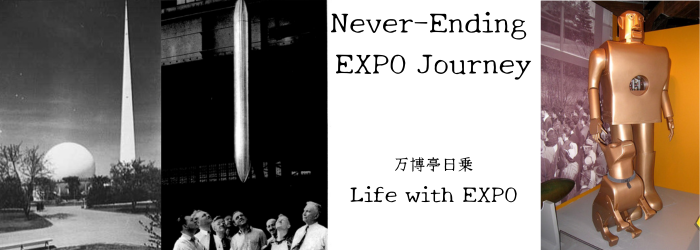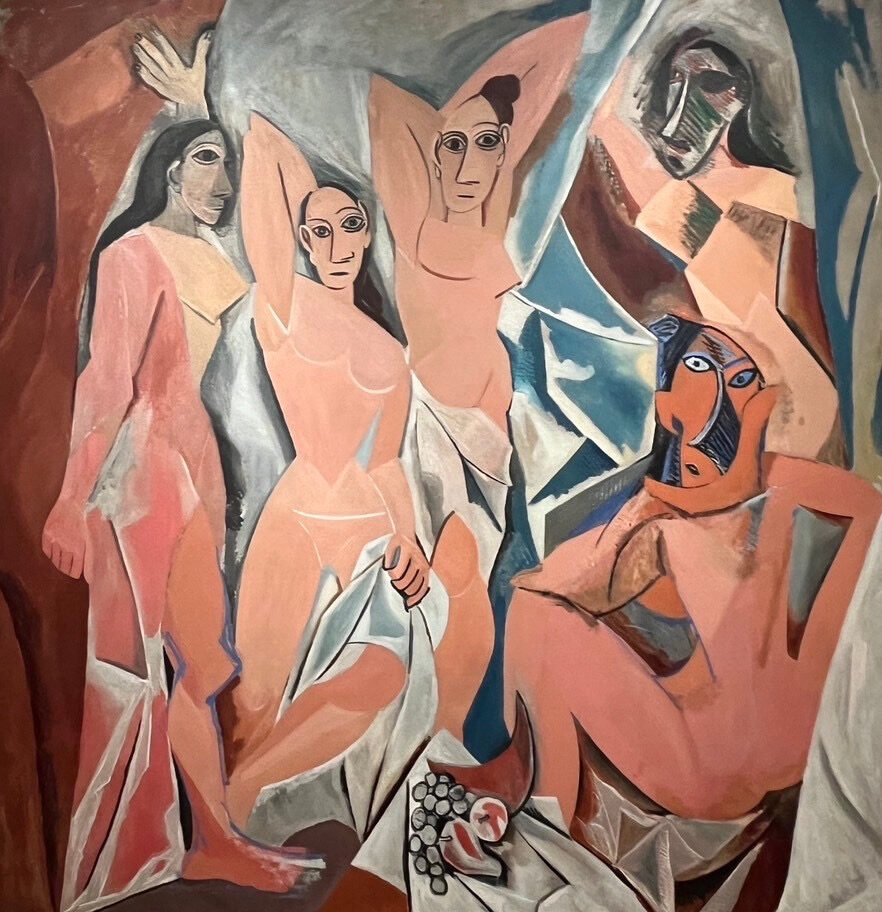“Les Demoiselles d’Avignon” by Pablo Picasso
In <32> ABSTRACTION The Genesis and Evolution of Abstract Painting, I touched a little bit on Pablo Picasso (1881-1973)’s“Les Demoiselles d’Avignon“ (243.9 x 233.7 cm, 1907, Museum of Modern Art, New York) .
It is considered to be one of Picasso’s most important works, and is also one of the most famous works, which is said to be the beginning of Cubism.
In Mr. Takashina Shuji’s “Eyes to See Masterpieces (Sequel) (Zoku Meiga wo miru me)”, this “Les Demoiselles d’Avignon” is picked up as a work by Picasso from among more than 100,000 works by Picasso.
It’s a work with that much significance.
Picasso’s “Bust of Woman (Fernande Olivier)” (1909, private collection) is on display at the
” ABSTRACTION The Genesis and Evolution of Abstract Painting” exhibition currently being held at the Artizon Museum. From there, in Episode <32>, I mentioned “Les Demoiselles d’Avignon” in which Fernande Olivier is said to be one of the models.
However, even after searching various books and information on the Internet such as the Museum of Modern Art, New York (MoMA) , which currently owns this work, I have never seen the fact that this work was exhibited at the World Expos.
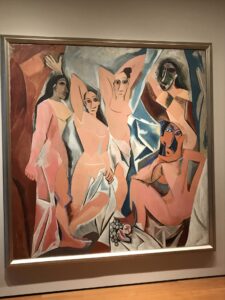
『アヴィニョンの娘たち』(MoMAにて筆者撮影。2019年)
“Les Demoiselles d’Avignon” (Photo taken by the author at MoMA in 2019)
Contact points between Picasso and Expo
Well then, how did Picasso relate to the World Expositions in the first place?
Speaking of Picasso and the World Exposition, “Guernica”, which was produced for the Spanish Republic Pavilion at the 1937 Paris Universal Exposition, is probably the most famous.
Exhibited “Last Moment” at the 1900 Paris Universal Exposition
However, the first point of contact between Picasso and the World Exposition was the 1900 Paris Universal Exposition.
Picasso was born in Malaga, Spain in 1881.
His father, Jose, wanted to be a painter, but gave up and became an art teacher.
He gave Picasso a special education.
In 1895, Picasso moved to Barcelona, where he entered the Royal School of Art of Sant Jordi Catalunya at the unusually young age of 14. This school was the most prestigious school in Spain at the time.
Here Picasso learned the basics of classical art. He seems to have been quite good, and he skipped a grade to join the advanced course.
One of his works from this period is “Science and Charity” (1897).
Picasso made this work when he was 16 years old, and this work won numerous awards and received high acclaim.
The “doctor” that appears in this work is said to have been modeled after his father Jose.
By this time, however, Picasso seemed to have already rebelled against the traditional art direction of his father Jose.
He met various artists at a café called “Els Quatre Gats” (Four Cats) in Barcelona, and was inspired by the new art movement Modernisme (Catalan; modernism in English. An art style similar to French Art Nouveau).
So Picasso began to rebel against the traditional arts demanded by his father, Jose, and gradually began to have conflicts with him.
Around that time, his father told him to paint a work called “Last Moment“.
This work was exhibited at the 1900 Paris Universal Exposition.
This work is no longer extant (as will be discussed later), but the sketch for it can be seen.
This is also a taste of traditional painting similar to “Science and Charity”.
So it can be imagined that his father’s strong intentions were reflected.
In October 1900, Picasso left for Paris with his best friend, Carles Casagemas, with his father’s permission, on the condition that he would paint this “Last Moment“.
By the way, it is said that the evaluation of “Last Moment” at the Paris Universal Exposition was disappointing.
Present of “Last Moment”
After arriving in Paris, Picasso and Casagemas decided to rent an attic apartment on the hillside of Montmartre, where artists gather.
One of Picasso’s works related to the Universal Exposition, drawn around this time, is “Leaving the Universal Exhibition, Paris, 1900”.
This work is like a monochrome sketch.
The painting shows four men and two women walking (hanging).
Two dogs can be seen in the foreground.
What can be seen behind the figures seems to be the Porte Bine (Bine Gate), which was built for the 1900 Paris Universal Exposition.
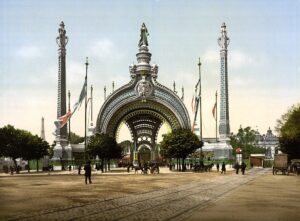
1900年パリ万博「ビネ門」
Porte Bine, 1900 Paris Exposition
Along with Picasso (second from the left) and Casagemas (second from the right), two women who live near the studio that they invited as models are drawn.
Germaine is the woman on the far right of the screen with her arms wrapped around Casagemas.
Germaine, Germaine’s sister, and her friend were models for Picasso and Casagemas.
It is said that the three of them are depicted in “Moulin de la Galette” (1900), the first oil painting work of Picasso in Paris.
The bewitching woman on the far left of the screen is said to be Germaine.
Many people think of Renoir’s work (1876, collection of Musée d’Orsay) when they hear “Moulin de la Galette”, but Picasso also painted a picture with the same title.
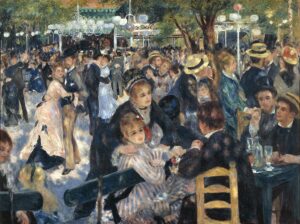
ルノワール『ムーラン・ド・ラ・ギャレット』
Pierre Auguste Renoir “Le Moulin de la Galette”
Picasso’s “Moulin de la Galette” seems to be more influenced by Lautrec than by Renoir.
However, his best friend Casagemas commits suicide because of this Germaine.
It was in 1901.
In fact, Picasso brought Casagemas to Málaga, Picasso’s hometown, in order to separate Casagemas from Germaine.
However, Casagemas returned to Paris while Picasso was away for an exhibition in Madrid, shot Germaine with a pistol (the bullet missed and she was safe), and then shot himself in the right temple. and died.
Germaine’s real name is Florontin (Gargaro), and she was actually already married and had a husband. This became clear after the death of Casagemas.
Picasso’s “Blue Period” begins with the sorrow of Casagemas’s death.
Picasso is said to have said, “Thinking about the death of Casagemas, I became a blue painter.”
The masterpiece of the “Blue Period” is said to be “La Vie” (1903, Cleveland Museum of Art).
In fact, in 1978, “La Vie” was X-rayed and a new fact was discovered.
The canvas on which this “La Vie” was drawn was the one that Picasso painted “Last Moment” for the 1900 Paris Exposition.
This means that (the canvas of) “Last Moment”, which was exhibited at the 1900 Paris Exposition, is now in the Cleveland Museum of Art in Cleveland, Ohio, USA, which owns “La Vie” in its collection.
Picasso painted over the traditional painting “Last Moment”, which his father had compelled him to paint, and then painted over it the masterpiece of his own “Blue Period”.
1937 Paris Universal Exposition and Picasso
Later, the connection between Picasso and the World Exposition was recognized in “Guernica”, which was produced for theSpanish Republic Pavilion at the 1937 Paris Universal Exposition.
I introduced this “Guernica” in detail in my book “EXPO 100 Stories, 1851-2025” (Yoshimoto Books, 2022), so please refer to it.
However, in addition to “Guernica”, Picasso exhibited other works at the 1937 Paris Universal Exposition.
This can be seen in the catalog of the “Masters of Independent Art Exhibition 1895-1937”, which I introduced in <26> “Matisse Exhibition” and Matisse’s works exhibited at the Expo.
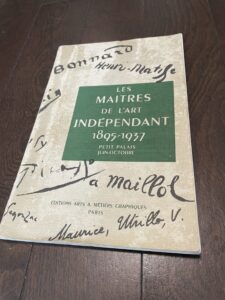
「独立美術の巨匠たち1895-1937展」カタログ
Catalog of “Les Maitres de l’Art INDÉPENDANT 1895-1937”
In addition to Matisse, many other artists we know appear in this catalog.
In other words, many painters we know participated in the 1937 Paris Universal Exposition.
For example,
Henri Rousseau, Signac, Vlaminck, Derain, Rouault, Marie Laurencin, Van Dongen, Vallotton, Maurice Denis, Emile Bernard, Vuillard, Bonnard, Dufy, Rodin, Picabia, De Chirico, Soutine, Modigliani, Chagall , Utrillo, Black, and Léger.
Discovered “Les Demoiselles d’Avignon” in the catalog of “Masters of Independent Art 1895-1937” (“Masters Exhibition”)!
And Picasso exhibited 32 works in this “Masters of Independent Art 1895-1937”.
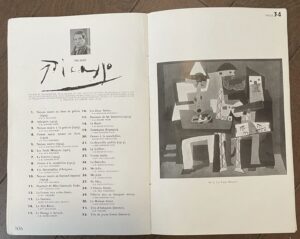
「独立美術の巨匠たち1895-1937展」カタログ P106-107
Catalog of “Les Maitres de l’Art INDÉPENDANT 1895-1937”, P106-107
And when I was checking the list of 32 works, I “discovered”
“Les Demoiselles d’Avignon“
at No.9.
As mentioned above, regarding Picasso’s “Les Demoiselles d’Avignon”, it is not possible to find any description related to the World Expositions from various sources.
However, in the official publication of the 1937 Paris Universal Exposiiton, the “Masters Exhibition” catalogue, the name of “Les Demoiselles d’Avignon” is described.
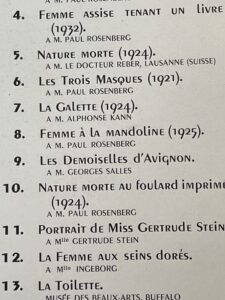
9. Les Demoiselles d’Avignon(アヴィニョンの娘たち)とある。
“Les Demoiselles d’Avignon” can be found at No.9
Upon investigation, the fact that there are other paintings with the same title is also not recognized.
Was “Les Demoiselles d’Avignon” really exhibited at the “Masters Exhibition” at the 1937 Paris Exposition?
From the production of “Les Demoiselles d’Avignon” to the acquisition by the Museum of Modern Art, New York (MoMA)
In the first place, “Les Demoiselles d’Avignon” was produced in 1907 in Montmartre, Paris, in a collective atelier and residence called “Bateau-Lavoir”.
However, for many years after this work was completed, Picasso kept it in his studio and did not show it to the public. It seems that many of the reactions by his friends were negative.
In 1916, it was finally exhibited at the Salon d’Automne.
This is when the work was first made public.
It is said that the exhibition space at that time was provided by the famous Paul Poiret (1879-1944).
Paul Poiret, as introduced in the <19> “Marie Laurencin et la mode” Exhibition, was called the “King of the fashion world” at the time, and Nicole Groult was a close friend (lover) of Marie Laurencin. He is the older brother of Nicole Groult. Paul Poiret had three sisters, the youngest of whom was Nicole.
However, the “photograph” of “Les Demoiselles d’Avignon” was published in 1910 in an article by Gelett Burgess titled “The Wild Men of Paris, Matisse, Picasso and Les Fauves” in “The Architectural Record”.
So the picture of this work was published and made available to the public at that time.
According to information published on the Internet and other sources, the following process followed.
The next public display of the painting after 1916 was an exhibition featuring Picasso and Matisse at the Paul Guillaume Museum in Paris in 1918. However, little information exists about this exhibition and paintings.
The painting remained rolled up in Picasso’s possession and was sold to designer Jacques Doucet (1853-1929) for 25,000 francs in 1924.
Between Doucet and Picasso, it was agreed that Picasso would receive 2,000 francs a month from the month following the date of negotiation until the total reached 25,000 francs. (In the end, Doucet paid 30,000 francs, more than the agreed price.)
Jacques Doucet died in 1929, leaving “Les Demoiselles d’Avignon” in the possession of Madame Doucet.
And on September 15, 1937, about a month before the 1937 Paris Universal Exhibition closed, the painting was sold by Madame Doucet to Jacques Seligman & Company for 150,000 francs.
Then, in November 1937, the Jack Seligman & Co. Art Gallery in New York City opened an exhibition titled “Twenty Years in the Evolution of Picasso. 1903-1923,” including “Les Demoiselles d’Avignon”.
In the same year, MoMA purchased “Les Demoiselles d’Avignon”. Trading ended in 1939.
MoMA hosted a significant Picasso exhibition, “Picasso: 40 Years of His Art,” from November 15, 1939 to January 7, 1940. This exhibition was curated by Alfred H. Barr Jr. (1902–1981), who was appointed the first director of MoMA at the young age of 27.
The exhibition featured 344 of his works, including his major 1937 painting “Guernica” and its study, and “Les Demoiselles d’Avignon”.
Let’s double check the history of this work on the MoMA homepage. The page for “Les Demoiselles d’Avignon” reads:
This work is included in the Provenance Research Project, which investigates the ownership history of works in MoMA’s collection.
And the provenance is described as follows.
The artist, Paris. 1907 – 1924
Jacques Doucet (1853-1929), Neuilly (Paris). Purchased from Picasso in February 1924 – 1929
Madame Jacques Doucet (Jeanne Roger), Neuilly. 1929-September 1937
Jacques Seligmann & Co., New York. Purchased from Madame Doucet in September 1937
The Museum of Modern Art, New York. Purchased from Seligmann, through the Lillie P. Bliss Bequest, in 1937. Transaction completed in 1939
This is the ownership history of this work compiled by MoMA.
Above, we read: ” on September 15, 1937, about a month before the 1937 Paris Universal Exposition closed, the painting was sold by Madame Doucet to Jacques Seligman & Company for 150,000 francs.” It mentions the Paris Universal Exposition of 1937, but there is no clear statement as to whether or not this work was exhibited at this Exposition.
“Les Demoiselles d’Avignon” may have been exhibited at the 1937 Paris Universal Exposition’s “Masters Exhibition” (held from June to October), and it is possible that the transaction was completed while it was still on display.
In this way, if we follow the chronological order, there would be no contradiction for the fact that “Les Demoiselles d’Avignon” was exhibited at the “Masters Exhibition” of the 1937 Paris Universal Exposition.
In any case, the title of the work is listed in the catalog of the “Masters Exhibition”, and there is no chronological contradiction with other facts. Also, there is no evidence to the contrary so far.
Therefore, it seems to be possible to conclude that “Les Demoiselles d’Avignon” is an artwork which was exhibited at a World Exposition.
